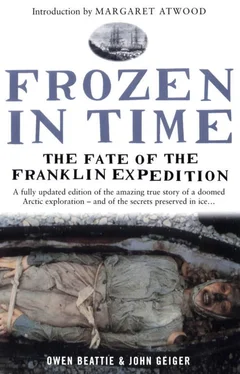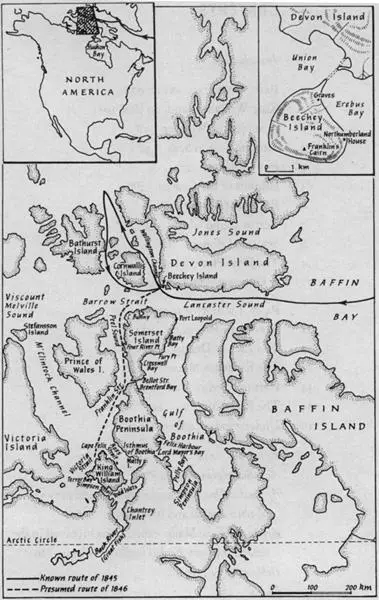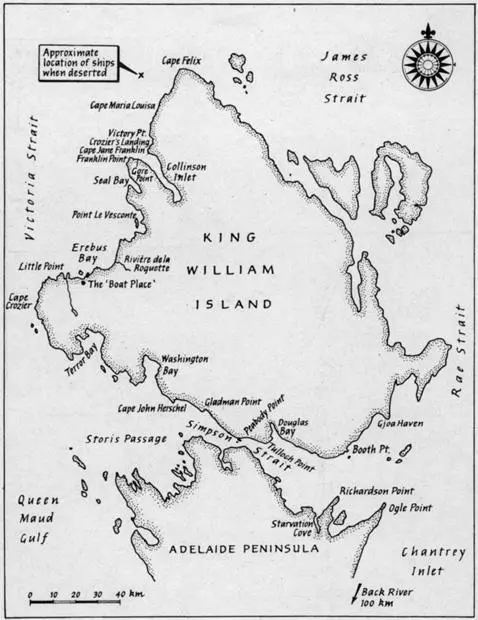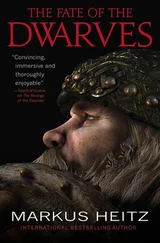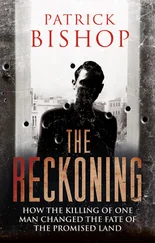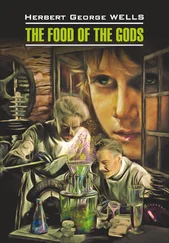Owen Beattie and John Geiger
FROZEN IN TIME
THE FATE OF THE FRANKLIN EXPEDITION
For Shirley F. Keen.—J.G.
For my first grandchild, A kasha (a.k.a. Pumpy)—O.B.

Frozen in time is one of those books that, having once entered our imaginations, refuse to go away. As I’ve been writing this introduction, I’ve described the project to several people. “ Frozen in Time ,” I say. They look blank. “The one with the picture of the Frozen Franklin on the front,” I say. “Oh yes. That one,” they say. “I read that!” And off we go on a discussion of forensic anthropology under extreme conditions. For Frozen in Time made a large impact, devoted as it was to the astonishing revelations made by Dr. Owen Beattie—including the high probability that lead poisoning had contributed to the annihilation of the 1845 Franklin expedition.
I read Frozen in Time when it first came out. I looked at the pictures in it. They gave me nightmares. I incorporated story and pictures as a subtext and extended metaphor in a short story called “The Age of Lead,” published in a 1991 collection called Wilderness Tips. Then, some nine years later, during a boat trip in the Arctic, I met John Geiger, one of the authors of Frozen in Time. Not only had I read his book, he had read mine, and it had caused him to give further thought to lead as a factor in northern exploration and in unlucky nineteenth-century sea voyages in general.
Franklin, said Geiger, was the canary in the mine, though unrecognized as such at first: until the last years of the nineteenth century, crews on long voyages continued to be fatally sickened by the lead in tinned food. Geiger has included the results of his additional research in this expanded version of Frozen in Time. The nineteenth century, he said, was truly an “age of lead.” Thus do life and art intertwine.
BACK TO THE FOREGROUND. In the fall of 1984, a mesmerizing photograph grabbed attention in newspapers around the world. It showed a young man who looked neither fully dead nor entirely alive. He was dressed in archaic clothing and was surrounded by a casing of ice. The whites of his half-open eyes were tea-coloured. His forehead was dark blue. Despite the soothing and respectful adjectives applied to him by the authors of Frozen in Time, you would never have confused this man with a lad just drifting off to sleep. Instead he looked like a blend of Star Trek extraterrestrial and B-movie victim-of-a-curse: not someone you’d want as your next-door neighbour, especially if the moon was full.
Every time we find the well-preserved body of someone who died long ago—an Egyptian mummy, a freeze-dried Incan sacrifice, a leathery Scandinavian bog-person, the famous iceman of the European Alps—there’s a similar fascination. Here is someone who has defied the general ashes-to-ashes, dust-to-dust rule, and who has remained recognizable as an individual human being long after most have turned to bone and earth. In the Middle Ages, unnatural results argued unnatural causes, and such a body would either have been revered as saintly or staked through the heart. In our age, try for rationality as we may, something of the horror classic lingers: the mummy walks, the vampire awakes. It’s so difficult to believe that one who appears to be so nearly alive is not conscious of us. Surely—we feel—a being like this is a messenger. He has travelled through time, all the way from his age to our own, in order to tell us something we long to know.
THE MAN IN the sensational photograph was John Torrington, one of the first three to die during the doomed Franklin expedition of 1845. The stated goal of the expedition was to discover the Northwest Passage to the Orient and claim it for Britain, the actual result was the obliteration of all participants. Torrington had been buried in a carefully dug grave, deep in the permafrost on the shore of Beechey Island, Franklin’s base during the expedition’s first winter. Two others—John Hartnell and William Braine—were given adjacent graves. All three were painstakingly exhumed by anthropologist Owen Beattie and his team in an attempt to solve a long-standing mystery: Why had the Franklin expedition ended so disastrously?
Beattie’s search for evidence of the rest of the Franklin expedition, his excavation of the three known graves, and his subsequent discoveries, gave rise to a television documentary and then—three years after the photograph first appeared—to the book you are holding in your hands. That the story should generate such widespread interest 140 years after Franklin filled his fresh-water barrels at Stromness in the Orkney Islands before sailing off to his mysterious fate is a tribute to the extraordinary staying powers of the Franklin legend.
For many years the mysteriousness of that fate was the chief drawing card. At first, Franklin’s two ships, the ominously named Terror and Erebus, appeared to have vanished into nothingness. No trace could be found of them, even after the graves of Torrington, Hartnell and Braine had been found. There is something unnerving about people who can’t be located, dead or alive. They upset our sense of space—surely the missing ones have to be somewhere, but where? Among the ancient Greeks, the dead who had not been retrieved and given proper funeral ceremonies could not reach the Underworld; they lingered in the world of the living as restless ghosts. And so it is, still, with the disappeared: they haunt us. The Victorian age was especially prone to such hauntings, as witness Tennyson’s In Memoriam, its most exemplary tribute to a man lost at sea.
Adding to the attraction of the Franklin story was the Arctic landscape that had subsumed leader, ships and men. In the nineteenth century very few Europeans—apart from whalers—had ever been to the far north. It was one of those perilous regions attractive to a public still sensitive to the spirit of literary Romanticism—a place where a hero might defy the odds, suffer outrageously, and pit his larger-than-usual soul against overwhelming forces. This Arctic was dreary and lonesome and empty, like the windswept heaths and forbidding mountains favoured by aficionados of the Sublime. But the Arctic was also a potent Otherworld, imagined as a beautiful and alluring but potentially malign fairyland, a Snow Queen’s realm complete with otherworldly light effects, glittering ice-palaces, fabulous beasts—narwhals, polar bears, walruses—and gnome-like inhabitants dressed in exotic fur outfits. There are numerous drawings of the period that attest to this fascination with the locale. The Victorians were keen on fairies of all sorts; they painted them, wrote stories about them, and sometimes went so far as to believe in them. They knew the rules: going to an otherworld was a great risk. You might be captured by non-human beings. You might be trapped. You might never get out.
EVER SINCE Franklin’s disappearance, each age has created a Franklin suitable to its needs. Prior to the expedition’s departure there was someone we might call the “real” Franklin, or even the Ur-Franklin—a man viewed by his peers as perhaps not the crunchiest biscuit in the packet, but solid and experienced, even if some of that experience had been won by bad judgment (as witness the ill-fated Coppermine River voyage of 1819). This Franklin knew his own active career was drawing to an end, and saw in the chance to discover the Northwest Passage the last possibility for enduring fame. Aging and plump, he was not exactly a dream vision of the Romantic hero.
Читать дальше
